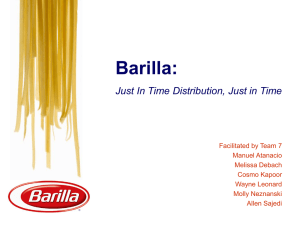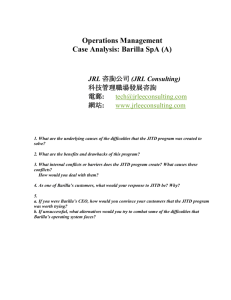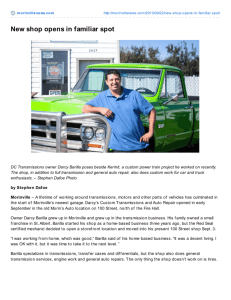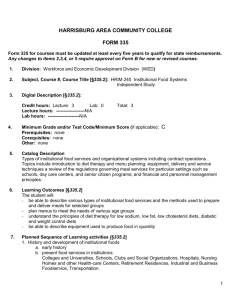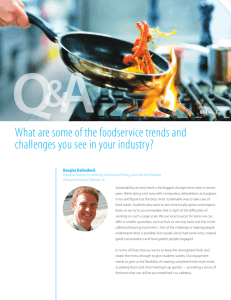THE VALUE CO-CREATING PROCESS: LESSONS LEARNED FROM THE CASE OF A
advertisement
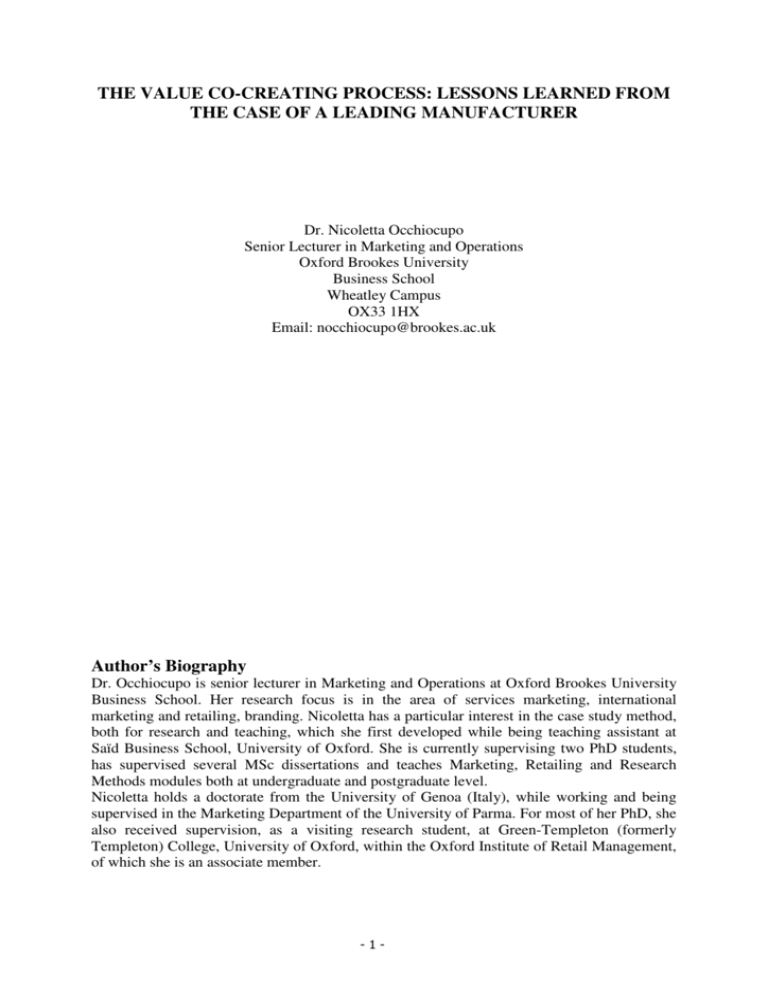
THE VALUE CO-CREATING PROCESS: LESSONS LEARNED FROM THE CASE OF A LEADING MANUFACTURER Dr. Nicoletta Occhiocupo Senior Lecturer in Marketing and Operations Oxford Brookes University Business School Wheatley Campus OX33 1HX Email: nocchiocupo@brookes.ac.uk Author’s Biography Dr. Occhiocupo is senior lecturer in Marketing and Operations at Oxford Brookes University Business School. Her research focus is in the area of services marketing, international marketing and retailing, branding. Nicoletta has a particular interest in the case study method, both for research and teaching, which she first developed while being teaching assistant at Saïd Business School, University of Oxford. She is currently supervising two PhD students, has supervised several MSc dissertations and teaches Marketing, Retailing and Research Methods modules both at undergraduate and postgraduate level. Nicoletta holds a doctorate from the University of Genoa (Italy), while working and being supervised in the Marketing Department of the University of Parma. For most of her PhD, she also received supervision, as a visiting research student, at Green-Templeton (formerly Templeton) College, University of Oxford, within the Oxford Institute of Retail Management, of which she is an associate member. -1- THE VALUE CO-CREATING PROCESS: LESSONS LEARNED FROM THE CASE OF A LEADING MANUFACTURER Purpose – The aim of this paper is to explore the process of value co-creation in a service centred logic with specific reference to the case of a world leading Italian manufacturer, Barilla, while entering the foodservice market in an innovative way. Design/Methodology/Approach The underpinning research methodology is qualitative and based on the case study approach, as highlighted by Yin (1994) and Eisenhardt (1989). The case is longitudinal, as data have been collected over a period of time. Both primary and secondary sources are used. Findings – The approach that Barilla chose in order to enter the foodservice market and develop this new business is very much focused on a strategic, long-term perspective, in which both the service provision and the development of strong relationships (defined “partnerships” by the Barilla’s management, so as to underline their long-term perspective) aim at the co-creation and definition of value by all actors involved. Research implications – The discussion of findings is aiming at providing a structured framework of the value cocreation process. The paper identifies four stages of value creation, combining essential lessons learned from the case with the literature previously explored. This four stages development builds upon the SDL and is seeking for a better understanding of how the SDL holds true in practice. Practical implications – Although generalization cannot be made out of a single case study, the paper has the potential to support organizations understanding the process of value co-creation, in which all actors are involved as operand sources. In that way, the SDL provides practitioners with a new paradigm and lenses to analyze, put in place and/or improve value creation processes. Originality/value – This paper is exploring the value co-creation process, combining a theoretical approach, mainly focused on the Service Dominant Logic, with a case study. Key words Value co-creation, Service Dominant Logic, processes, service solution, foodservice, Paper type – Research paper -2- INTRODUCTION The aim of this paper is to explore the process of value creation in a service centred logic with specific reference to the case of world leading Italian manufacturer, Barilla, while entering the foodservice market in an innovative way. On basis of Barilla’s case study analysis, we also suggest that Vargo and Lusch’s (2004; 2008a; 2008b; Lusch and Vargo, 2006a) groundbreaking theory of a new service-dominant logic for marketing holds true in practice. Foodservice represents a challenging alternative channel to the ‘more traditional’ retail channel to reach and acquire consumers. During the last decades, food consumption across Europe has been evolving towards a higher expenditure on eating out, implying a fast growth for the foodservice sector in comparison with the retail sector. Given this context, one strategy adopted by some branded manufacturers is to enter the foodservice market, as an alternative to the retail channel, in order to reach, acquire and retain customers. In 1996, Barilla, the largest Italian food-processing company, decided to approach this market in a more structured way by starting a new division, called Barilla Foodservice. This was created on the basis of the belief that the profitability of the sector would be directly proportional to market specialization. Acknowledging that sustainable competitive advantage could not be reached by slightly differentiating the existing products, Barilla focused on supplying to foodservice operators not just a product but service-solution, building strong partnerships with them. The outcome of this has been the active contribution of all economic actors in value creation. In doing this, the Italian company pursued two goals: to satisfy consumers in a unique way and give more visibility to the manufacturer brand in an, until then, unbranded market. The case study supports Vargo and Lusch’s theory of service-dominant logic originally published in 2004 and then further developed (Vargo and Lusch, 2006; 2008a; 2008b; Lusch and Vargo, 2006a). The paper starts with discussing the service dominant logic first proposed by Vargo and Lusch (2004), emphasising some key elements related to the value creation long term perspective also reflected by the evolving definition of marketing, the relevance of intangible resources and processes rather than tangible resources and output and the co-creation of value in a relationship centred approach in which all actors involved are operant sources. Then the chosen methodology – longitudinal case study of an Italian world leading food manufacturer – is discussed focusing on the explorative element of it. A brief overview of the foodservice sector is followed by the case study, which is incorporating the initial journey of Barilla Foodservice in developing a service-centred solution for their customers (both intermediate and final) and the first partnership they established with a German foodservice operator (Tank und Rast) in doing so. The discussion of findings is aiming at providing a structured framework of the value creation process identifying four stages of development combining essential lessons coming from the case with the literature previously explored. LITERATURE REVIEW Through our study of Barilla’s novel approach in the foodservice market, we identified an application of the dominant logic for marketing proposed by Vargo and Lusch (2004; 2008a; 2008b; Lusch and Vargo, 2006a). These most recent, emerging perspectives of marketing put more emphasis on a marketing logic which has at its core intangible resources, value co- -3- creation and relationships rather than the traditional elements of tangible resources, embedded value and transactions (Vargo and Lusch, 2004). The emerging and increasing shift of interest for management disciplines – among which marketing, but not only – in understanding and praising for the need of a more customer centric approach (see for example Berthon et al., 1992) and the importance of understanding how companies generate value for their customers, moving from the traditional view of a series of value chain activities (Porter, 1985) to a value chain constellation (Normann and Ramírez, 1993) and up to the concept of generating value with the customers through coproduction (Normann and Ramírez, 1993) has been instrumental for a paradigm shift that has been taking shape after the groundbreaking first paper by Vargo and Lusch (2004). Vargo and Lusch (2004, p.1) argue that these new perspectives “are converging to form a new dominant logic for marketing, one in which service provision rather than goods is fundamental to economic exchange”. Through a thorough review of 100 years of marketing thought, the authors conclude that “marketing has moved from a goods-dominant view, in which tangible output and discrete transactions were central, to a service-dominant view, in which intangibility, exchange processes, and relationships are central” (ibid, p.2). In 1992, Webster noted that “marketing has tactical, strategic and cultural dimensions”. In accordance with the evolving dominant logic of marketing proposed by Vargo and Lusch (2004), the latest definition of Marketing released by the American Marketing Association in 2007 (AMA, 2011) underlines the importance of the strategic dimension of marketing in a long-term success perspective for companies, reinforces the relevance of the concept of value and extends the process of value creation beyond the company and its immediate stakeholders. The strategic long-term dimension and the concept of value were absent in the 1985 definition of Marketing by AMA (AMA, 2007), as that made reference to a goodsdominant view, which was based on the 4Ps and focused on the tactical aspects of marketing, in a short-term, non-relational perspective. Likewise, the previous AMA definition (1935) and the Chartered Institute of Marketing definition (2011) are not referring to the concept of value creation and do not identify relationships as key elements of this activity. With no aim of providing an exhaustive set of existing definitions of marketing, Tab. 1.1 below is briefly summarising the historical evolution of the marketing definition by AMA and the Chartered Institute of Marketing, with the intent of exploring the key emerging elements associated to it and reflecting a paradigm shift. Tab. 1.1 Marketing definitions: a paradigm shift Marketing Definition Key Elements 1935: “Marketing is the performance of Goods dominant view, 4Ps centred, seen as a business activities that direct the flow of tactical element, short term non-relational, goods and services from producers to relegated to a particular function within the consumers” (AMA, 2007) organisation 1985: “Marketing is the process of planning and executing the conception, pricing, promotion, and distribution of ideas, goods and services to create exchanges that satisfy individual and organizational objectives” -4- (AMA, 2007) 2011: “Marketing is the management process that identifies, anticipates and satisfies customer requirements profitably” (CIM, 2011) 2004: “Marketing is an organizational function and a set of process for creating, communicating and delivering value to customers and for managing customer relationships in ways that benefit the organization and its stakeholders” (Keefe, 2004; AMA, 2011) Introduction of the concepts of set of processes, value, relationships and stakeholders. Still seen as a organizational function rather than a cross-organizational function 2007: “Marketing is the activity, set of institutions, and processes for creating, communicating, delivering, and exchanging offerings that have value for customers, clients, partners, and society at large. (AMA, 2011) Long term strategic view, relationship centred, focusing on value creation by and for all different actors involved in the process and on the exchange of offerings rather than goods; regarded as an activity rather than a single function within the organisation Apart from influencing the shaping of the latest definitions of marketing, the service dominant logic, which was first proposed by Vargo and Lusch in 2004, has attracted much attention and became the subject of rigorous academic debate in the field (see for example, Aitken et al, 2006; Grönroos, 2006; Lusch and Vargo, 2006a; Schembri, 2006; Bolton et al, 2007; Maglio and Spohrer, 2008). The discussion is still on-going, dynamic and very much open to contributions. As the authors themselves argue, the original paper ‘have stimulated a lively and ongoing world wide discussion about the nature of the market and marketing’ (Gummesson et al., 2010, p.9) and it seems also very clear that it is ‘potentially providing a reorienting perspective on the market for the firm as a whole’ (ibid, 2010, p.10) rather than focusing on the marketing aspect only. Lovelock and Gummesson (2004), while debating the need for a new paradigm in the services marketing domain, interpreted the initial contribution of Vargo and Lusch (2004) as consistent with one of the four a potential ‘alternative routes’ for services marketing, whereby “services marketing and goods marketing should be reunited under a service banner” (Lovelock and Gummesson, 2004, p.37). After 2004, both Vargo and Lusch have explained, clarified and further developed the key ideas proposed in their initial groundbreaking paper (see Lusch and Vargo, 2006a; Lusch and Vargo, 2006b; Lusch et al, 2007; Vargo, 2008; Vargo and Lusch, 2008a; Vargo and Lusch, 2008b; Vargo et al, 2008; Lusch et al, 2009; Vargo and Akaka, 2009; Gummenson et al, 2010). As a result, the foundation premises, which were originally eight (Vargo and Lusch, 2004), have been extended to ten (Vargo and Lusch, 2008a). Essentially, the key elements highlighted by the service dominant logic are: service, value cocreation, operant sources, process orientation and relationship building. The service is seen as the fundamental basis of exchange and can be defined as ‘the application of specialised competences (knowledge and skills) through deeds, processes, and -5- performances for the benefit of another entity of the entity itself’ (Lusch and Vargo, 2006b). Furthermore, service processes are so central to the economic activity that they are the purpose of the activity, which is aiming at ‘seeking and providing solutions. That is service is exchanged for service’ (Lusch et al, 2009, p.1). Both the producer and the consumer are involved in the value creation, co-creating value (Vargo and Lusch, 2004, 2008a) and acting as operant sources. Key is the understanding that in fact also consumers are operant sources, involved in the value creation, rather than operand sources, targeted and ‘passive’ recipients of actions initiated by the company. This concept was proposed by Normann and Ramírez (1993) and defined as value-creating system. Furthermore, a key element of the new service dominant logic is process orientation instead of output orientation, since the focus is moving from units of output to ‘mutually satisfying interactive processes’ (Vargo and Lusch, 2008b, p.31). In a process oriented logic the valuein-use is contrasting the good-based view of value-in-exchange and the consumer is seen as ‘endogenous to the value-creation process’ (Vargo and Lusch, 2008b, p.31). Finally, within this value creating network, relationships become a central aspect of the value creation, since companies ‘can only offer value proposition’ (Vargo and Lusch, 2008a, p.7) instead of simply delivering value. As such value is determined by the beneficiary in a unique way. As Grönroos (2006, p. 327) also pointed out, ‘in service consumption, coproduction and co-creation of value takes place during the consumption process.’ The approach that Barilla chose in order to enter a fast growing market and develop this new business is very much focused on a strategic, long-term perspective, rather than a tactical, transactional approach. In this in which both the service provision and the development of strong relationships (defined “partnerships” by the Barilla’s management, so as to underline their long-term perspective) aim at the co-creation and definition of value by all economic actors. As Vargo and Lusch (2004, p. 6) suggest, “a service-centred dominant logic implies that value is defined by and cocreated with the consumer rather than embedded in output”. RESEARCH METHODOLOGY This research aims to explore ways in which companies create value in the foodservice market. As such, the case study (Eisenhardt, 1989) appears to be an appropriate research methodology “to explore a contemporary phenomenon within a real life context where the phenomenon and the context are not clearly evident, and in which multiple sources of evidence are used” (Yin, 1994, p.23). Furthermore, Gummesson (2007) also emphasises the ability of case study research to ‘handle complexity, context and change’ Among different companies considered, Barilla was chosen for a number of reasons, the most important of which are: 1. the Barilla Group, due to its interesting and innovative business approaches (Roberts, 2004) has become the subject of a 1994 Harvard Business School case study: “… Pietro and Gianni Barilla [second generation family owners of the firm from ‘40s] differentiated their company with a high quality product supported by innovative marketing programs. Barilla Group revolutionized the Italian pasta industry’s marketing practices by creating a strong brand name and image for its pasta, selling pasta in a sealed cardboard box with a recognizable color pattern, rather than in bulk, -6- and investing in large-scale advertising programs…”. This first Harvard Business Case Study (Hammond, 1994) focused on the novel way in which Barilla approached logistics practices. Again, in 2006, Harvard Business School has published a case study (Bell, 2006) focusing on a new business initiative, ‘Academia Barilla’, launched by Barilla a few years earlier and aiming at the diffusion of authentic Italian food traditions and values around the world. 2. Barilla has internationally built a strong reputation and, over the years, has been consistently appearing in international rankings in terms of company reputation. In 2006, for example, Barilla was ranked by the Reputation Institute n. 1 in the world for company reputation and n.3 in 2007 (Vergnano, 2006); in 2010 n. 19 in the world, still n. 1 among Italian companies (Reputation Institute, 2010) 3. their approach in the foodservice market is well structured and seems to be (potentially) transferable to other firms Research access and data collection As Dopson (2003, p.219) mentions “the literature on case study design ignores the importance of the negotiation of access to the case site”, although this is a significant issue for the feasibility of any research. Barilla1 offered an excellent support for the data collection and that has been key for the present study and the collection of high quality data. Although the case study here presented is focusing on the initial stages of the creation of the Foodservice division and the first partnership involving the full implementation of the pasta corner system, the data collection has been done over a period of time of about three years. Further developments over the past four years, which are not included in the present paper, have also been periodically discussed by the author with company informants, through interviews and provision of material and more informal meetings with managers from the company. The research has been conducted through: - semi-structured personal interviews with executives and senior managers, who have been managing the Barilla Foodservice project since its beginning and therefore have a broad overview of the relevant issues. The research schedule covered the following areas: the company’s strategic approach to the foodservice, the reasons behind the relevant strategic choices, the organisational matters linked to the new division and the future perspective of the business. These questions led into the discussion of the specific case study presented here; - attendance of division managers’ presentations followed by a personal discussion with the speakers; - attendance of international exhibitions attended by Barilla Foodservice - primary data collection in the form of internal and confidential reports - secondary data collection: market research reports, academic databases, internet The possibility of collecting and using multiple sources of evidence and of having follow up discussion with manager has obviously provided an excellent base for the data analysis and the case study building. 1 The author is grateful for the access to data provided by Barilla and the managers that were in charge of Barilla Foodservice during the years this case focused on - their time and contribution have been key elements to the development of this paper; -7- THE FOODSERVICE INDUSTRY: AN OVERVIEW (1997-2004) Some of the key features of the foodservice industry around the period in which the case here presented develops are summarised below. Foodservice could be defined as “the provision of meals, food and refreshments fully prepared away from home; mostly eaten away from home (but including delivery and take away)” (Promar International, 2000). The foodservice sector is traditionally divided into two key categories: - “commercial”: restaurants; hotels; cafés, pubs, fast food/quick service restaurants (QSR); travel; leisure - “non commercial”: business and industry; healthcare; education In some countries (e.g. France and Italy), the Foodservice industry is identified under the Ho.Re.Ca. name, Hotel, Restaurant and Catering, and/or referred to as ‘out-of-home’. According to worldwide industry trends, between 1999 and 2003, the compound annual growth rate of global foodservice sales had been approximately 3,2%, with growth forecast, and therefore foodservice was considered a “boom industry” (Weinberger, 2004). According to the same source, 80% of these sales were produced by Western Europe, North America and Japan, totalling 1,684 billion US dollars. In terms of consumer spent, many sources pointed out that in the U.S. only about 50% of the North American family’s budget was spent on retail shopping, since the other half is spent on foodservice (Promar International, 2000; Costa, 2001; Senauer, 2001). In Europe, however, the situation was quite different, as the average spent in the foodservice industry at the end of the twentieth century was about 33 % of total food expenditure (Promar International, 2000, see fig. 1). Fig. 1: The proportion of consumer spend on foodservice and retail, 1999 Italy Germany France Spain Netherlands UK USA 0 20 40 Foodservice sales Source: Promar International, 2000 -8- 60 80 Retail food sales 100 This percentage could vary quite significantly from one country to another, because, although the European foodservice market as a whole presented some common features, each market had a size, nature and stages of development that reflected, apart from industry factors, sociocultural and demographic diversity. Sales in the European market represented 33% of the world total, with a growth of approximately 22% between 1999 and 2003; UK, France and Germany together generated more than 50% of the total European sales (Weinberger, 2004). According to a number of sources (Ribeiro Soriano, 2002; Robertson, 2002; Costa, 2001; Senauer, 2001; Promar International, 2000; Mawson & Fearne, 1997), the most remarkable reasons of the foodservice market consolidation were: • • • • • • • Increased disposable income The growing number of working women, which implied a decreasing time dedicated for meal preparation at home Households composition, as the number of small or single households was larger than in the past and these households tended to either consume meals away from home or prepared meals The lack of cooking skills Unlike in the past, due to the work schedules, it was increasingly unlikely that people would go back home for lunch (e.g. the case of Italy and Spain) People travelled more and hence tended to appreciate and be more open in trying new tastes and meals from foreign countries. This has led to a growth of ethnic food and restaurants Greater use of leisure time BARILLA AND BARILLA FOODSERVICE Barilla G. e R. F.lli S.p.A.2 is one of the two operative companies that are controlled by Barilla Holding S.p.A., which owns 49 production facilities (14 in Italy and 35 outside Italy) in 10 countries and employs over 15,000 people, with group revenues in 2009 of more than € 4,171 million. It exports products in more than 150 countries. (Barilla Group, 2011) Barilla Holding S.p.A. is leader in the pasta business worldwide (with a 28% market share in the U.S. for example), in the pasta sauces business in continental Europe, in the bakery products business in Italy and in the crispbread business in Scandinavia; the company, still owned by the Barilla family, was founded in 1877 in Parma (Italy), where it still has its headquarters (Barilla Group, 2011). Barilla has been monitoring the business opportunities through the foodservice channel since the early 1990s, simply by developing specific larger packaging for this market. However, in 1996, under the lead of Edwin Lewis Artz, former CEO of P&G, Barilla decided to create a new division dedicated to the foodservice. Barilla Foodservice has been created with the aim to “be responsive to the growing and complex expectations of the consumers in the out of home” and “have Barilla become the favourite label of the operators in this important market”. (Barilla Financial Statement, 1997) 2 Through the paper the simple denomination Barilla will make reference to Barilla G. e R. F.lli S.p.A.; -9- BARILLA FOODSERVICE: INITIAL STEPS IN A NEW MARKET Due to lack of information on the foodservice market, Barilla Foodservice spent the first year collecting information from all available sources, including direct market research. They realised that there was effectively a very low level of specific knowledge in the market and that, in particular, it was extremely difficult to distinguish the flow of pasta sales, attributing them either to the retail channel or the foodservice. That proved to be even harder to establish outside Italy, where many restaurants were used to buying Barilla pasta in supermarkets or hypermarkets. After carefully evaluating existing possibilities, given the Barilla broad product and brand portfolio, Barilla Foodservice decided to focus the business on pasta meals rather than introduce the company’s bakery line. Some researches also showed a worldwide growing trend of eating ethnic food (e.g. Italian food outside Italy), and particularly Italian, despite the lack of ability of foodservice operators to obtain authentic Italian pasta meals. Data provided in tables 1 and 2 clearly point out that pasta is a type of food appreciated all over the world. Nevertheless, it is not always considered a proper meal and, in many countries, it is used as an accompaniment to other dishes, which is not how Italian pasta is traditionally served. Tab. 1: Annual world pasta consumption, 2008 (kg / per capita) Italy 26.0 Bolivia 4.8 Venezuela 12.9 Netherlands 4.4 Tunisia 11.7 Lithuania 4.4 Greece 10.4 Latvia 4.1 Switzerland 9.7 Australia 4.0 Sweden 9.0 Israel 4.0 United States 9.0 Dominican Rep. 4.0 France 8.3 Costa Rica 3.8 Chile 8.2 Panama 3.8 Peru 7.5 Finland 3.2 Germany 7.4 Colombia 3.0 Argentina 7.2 Poland 3.0 2.7 Brazil 6.7 Romania Portugal 6.7 Mexico 2.7 Hungary 6.5 Ecuador 2.6 Canada 6.5 United Kingdom 2.5 Czech Republic 6.0 Guatemala 2.0 Russia 6.0 Denmark 2.0 Turkey 6.0 Libya 2.0 Austria 5.6 Japan 1.7 Belgium - Lux. 5.4 Egypt 1.2 Estonia 5.3 Ireland 1.0 Spain 5.0 El Salvador 1.0 Slovak Republic 5.0 Source: Unione Industriale Pastai Italiani, 2009 – www.unipi-pasta.it - 10 - Tab. 2: World pasta production, 2008 (tons.) Italy 3,161,707 Portugal 78,000 United States 2,000,000 Czech Republic 70,000 Brazil 1,500,000 Hungary 70,000 Russia 858,400 Dominican Rep. 65,000 Turkey 606,620 Romania 52,600 Egypt 400,000 Switzerland 49,519 Venezuela 350,333 Bolivia 43,000 Germany 305,000 Guatemala 38,000 Argentina 291,300 Austria 37,803 Mexico 280,000 United Kingdom 35,000 France 252,756 Ecuador 32,000 Spain 234,643 Costa Rica 22,000 Peru 231,493 Slovak Republic 22,000 Canada 170,000 Sweden 20,200 Chile 155.000 Jordan 20,000 Poland 150,000 El Salvador 13,000 Greece 145,000 Syria 9,005 Japan 144,500 Lithuania 5,976 Colombia 131,270 Panama 4,364 Tunisia 110,000 Latvia 1,845 India 100,000 Estonia 1,400 Source: Unione Industriale Pastai Italiani, 2009 - www.unipi-pasta.it Barilla Foodservice launched the first dedicated product in 1997 and consisted of a kind of pasta produced with a particular processing. The aim was to respond to the foodservice operators’ demand for high standard quality at a reasonable cost. This pasta would guarantee the best performances after multiple cooking phases, which is a normal practice in modern restaurants. The pasta normally sold in grocery retail shops is not supposed to be cooked more than once nor in big quantities, as it is produced for home consumption. Although the development of this product by Barilla could be considered a first important step to secure the preference of foodservice operators, still it did not represent a very stable source competitive advantage, nor a way to obtain brand awareness through the foodservice market and involve the final consumer in the process. In 1999, Barilla Foodservice started a new project, named “Pasta World”, aiming at exploring new business opportunities so as to keep benefiting from the brand awareness already achieved through the retail channel. The possibility of a vertical integration was evaluated, as that could lead to the creation of an innovative restaurant point of sale: the “Pasta Store”. The idea was however abandoned, because this business would have resulted in a very large shift from the company’s core business. - 11 - A second option, named “Food Show”, became effective and consisted of the creation of a new concept, in which the consumer would be involved in the experience of cooking through the process of “front cooking”3. That was also supporting the strong belief that the profitability of the sector was directly related to the market specialization. Barilla Foodservice decided to focus on supplying to foodservice operators not just a product (pasta), but a complete business solution, building strong partnerships with them. To achieve this goal, the company initiated a partnership with one of the most qualified manufacturers of cooking equipment4, so as to realise the idea of Food Show, working together on equipment that could be tailored to Barilla’s needs. A first test of this new concept was conducted in collaboration with a French partner5, one of the largest foodservice operators in Europe. The results confirmed the validity of the Food Show idea and provided an incentive to continue, working on improving the offer in terms of product, processes and equipment. In order to better tailor the building system to the needs of potential partners in the foodservice market and increase brand awareness among consumers, Barilla focused on two market features: 1. business customers were seeking products and processes capable of guaranteeing consistent quality of the final product served to the consumers in the quickest possible way 2. final consumers were increasingly looking for quality and quick service As a response to foodservice operators’ expectations and consumer needs, Barilla Foodservice introduced a series of products and processes innovations, which all flowed into the “Pasta Cooking System”, an integrated system of products, equipment, specific preparation processes and complementary services. The introduction of technological innovations in the meal ingredients supplied supported the launch of this new system, as Barilla Foodservice developed “Block Frozen Pasta” and “Frozen Sauces”, which would provide a high quality pasta meal in the quickest possible way. While the first version of this system, called Pasta Meal System, was entirely relying on the use of frozen ingredients, with the Pasta Cooking System it became possible to also use the process called “Express cooking”, which referred to pasta produced with a special treatment, but not frozen, providing foodservice operators with an additional option. The “Pasta Cooking System” offered some unique benefits to business customers, such as: 1. modular equipment, because it was possible to adapt the system to the needs of the client, not only in terms of ingredient choice, but also in term of space and equipment 3 In the literature, there is an interesting reference by Romm (1989) to the concept of restaurant as theatre, a model that “emphasizes the responsibility of providing a participative experience for the customer” and it is also pointed out that “the restaurant isn’t simply like show business. It is show business”; 4 The name cannot be disclosed for confidentiality reasons; 5 The name cannot be disclosed for confidentiality reasons; - 12 - 2. high level of productivity, due to the quick and easy process of meal preparation, limiting, at the same time, waste 3. a broad line of product choices 4. minimising human resources costs 5. possibility of offering, all day, a standardised high quality pasta meal at a reasonable price 6. a system capable of being also used by foodservice operators without professional kitchen equipment or expert cookers This business solution was the premise for the creation of the Barilla “Pasta Corners”, through which Barilla could gain brand awareness in the Foodservice market and, hence, growing the market and differentiating itself from its competitors. The “Pasta Corner” was an innovative concept for quick food service restaurant, consisting of the reproduction - in a small area - of a real kitchen, with dedicated spaces to store frozen pasta and sauces and a front cooking space (see exhibit 4). It allowed a non specialized worker to prepare two pasta dishes in one minute, making preparation easier and offering consistently high quality meals. At the same time, in line with the Food Show concept, the pasta was prepared in front of the consumer. In line with Barilla brand image and reputation and with the features and potentiality of the “Pasta Cooking System”, as an ideal partner, the company sought medium – high quality chain in the world of modern restaurants, with specific reference to the out-of-home market outside Italy. A “PASTA CORNER” PARTNERSHIP: BARILLA AND TANK UND RAST: The first partnership including a complete application of the Food Show concept supported by the “Pasta Cooking System”, was developed in Germany in collaboration with a German company, Autobahn Tank und Rast, which was identified as a leading provider of services (fuel, hotels, shops and foodservice) on German motorways and, at that time, was also ranked as third in the German catering market after McDonald’s and LSG Sky Chef. The Food Show concept was based on the “Pasta Corner”, developed by Barilla Foodservice and the above named partner, with whom cooking equipment was jointly projected and then realised. In April 2000, Barilla Foodservice started the first contacts with the German company, the profile of which was thoroughly researched on the basis of the company’s business values: a leader in its sector, focused on high quality standard services, customer-oriented and looking for the development of innovative new concepts and services, cooperation with strong partners and brands as well as yield-oriented investment. After over a year of negotiations, Barilla and Tank und Rast, began their partnership and, in the second half of 2001, they introduced an unbranded pasta corner, to test the impact that this would have on the market. Until then, pasta for Tank und Rast was considered just an accompaniment, not a main meal. The test results were excellent and set the basis for continuing to develop what Barilla was considering a joint project. At the end of 2002, the first branded Barilla pasta corner was installed in a Tank und Rast point of sale. In March 2003, the two companies signed a formal - 13 - agreement, according to which, Tank und Rast committed to introduce the Barilla “Pasta Corner” in 250 of its restaurants on German motorways, by the end of the 2005, for an estimate turnover of 20/25 million euro. In 2008, 146 “Pasta Corner” was effectively fully operating. Roles and responsibilities of each partner were clearly defined and the project was carefully monitored since the very beginning, in terms of its (qualitative and quantitative/financial) performances. In addition to that, both companies were interested in understanding its ability, on the one hand, to better reach and satisfy consumers and, on the other hand, to make the partnership profitable for both companies. “Mystery Dining” tests by an independent organisation were conducted twice a year and the feedback provided a useful source of information on the basis of which further improvements were introduced to the benefit of both the partners and the consumers. Barilla Foodservice’s also actively pursued the objective of creating brand awareness synergies between the out-of-home market and the retail market through a series of promotions, consisting for example in a free box of pasta Barilla for each large portion of pasta bought by Tank und Rast consumers. The results of this partnership are considered positive and Barilla Foodservice has been further developing these type of business partnerships across a number of different countries, including (but not limited to) France, Switzerland and Italy. However, for confidentiality reasons, it is not possible to disclose financial details. DISCUSSION This paper proposes that Barilla’s process of entry in the Foodservice market provides empirical evidence of four development stages, which have led Barilla from supplying a product to supplying a service-solution, through a process of relationship-building and value co-creation. That seems to provide very clear evidence of a dynamic, very focused processoriented approach to the market. From the very beginning, the focus on the brand and the customers (both business and final) has led all decisions. A new logo was created in order to distinguish the product lines dedicated to the foodservice, even though the colours and the Barilla style and brand signature were kept so as to be easily recognisable (see fig. 2). Fig. 2 – Barilla F.lli S.p.A. and Barilla Foodservice Logos Source: © Barilla, company sources - 14 - The key strategic objectives of Barilla’s new division consisted of: 1. decreasing the dependency from the trade in the grocery retailing 2. creating synergies between foodservice and retail 3. letting customers experience products 4. developing ‘new professional products’ 5. achieving volumes and growth in the ‘out-of-home’ market 6. sustaining the premium positioning of the brand and increasing the brand equity in a unbranded market (foodservice) In line with the service dominant logic developed by Vargo and Lusch (see for example, 2004; 2008a; 2008b; Lusch and Vargo, 2006a), Barilla sought ways to involve customers – and more in general all actors involved in the process, such as for example the manufacturers of cooking equipments - in the co-creation of value, being process driven and embedding the value creation in a network of relationships with the different economic actors involved. In the process of looking for a better understanding of the stages of development of this project and in an attempt to generalise based on the Barilla Foodservice case study, a number of theoretical perspectives are employed and summarised in the table below. Tab. 3 - An organising framework for value creation in a service centred context First stage Development of a Customer specific product for orientation the business segment Second Introduction of the stage Food Show concept: focus on consumer involvement in building brand awareness in the foodservice Consumer based value creation Third stage Serviceoriented marketing view Offer of a complete service-solution, including technological cooking elements The focus is on understanding and adapting the offer to the customers’ needs. “Identifying the needs and wants of the target market – and delivering products and services that satisfy these needs – is the key to the attainment of organizational goals” (Berthon et al., 1999, p.37) The consumer becomes part of the value constellation and contributes in the value creation. “The interactive and integrative view of exchange is more compatible with the other normative elements of the marketing concept, the idea that all activities of the firm be integrated in their market responsiveness and the idea that profits come from customer satisfaction (rather than units of goods sold)” (Vargo & Lusch, 2004) The high content of specific technology included in the product offers a unique service – centred proposition, in which all actors are actively involved in the creation of a unique value proposition. “The service-centred oriented view of marketing implies that marketing is a continuous of social and economic processes that is largely focused on operant resources which the firm is constantly striving to make - 15 - Fourth stage Building partnerships better value proposition than its competitors.”(Vargo & Lusch, 2004) Value The creation of value is pursued through the creating engagement of strong partnerships. system “Successful companies do not just add value, (cothey reinvent it. Their focus of strategic production) analysis is not the company or even the industry but the value-creating system itself, within which different economic actors – suppliers, business partners, allies, customers – work together to co-produce value” (Normann & Ramírez , 1993) The case study could be therefore summarised and analysed further discussing the four stages of this process incorporating the four theoretical components briefly mentioned in the table above. 1. The first stage is characterised by customer orientation. When Barilla started the process, they not only analysed the market in terms of the “environment”, but also, mainly, focused on customers’ (both business and final) needs. As Berthon et al. (1999, p. 37) suggested: “Identifying the needs and wants of the target market – and delivering products and services that satisfy these needs – is the key to the attainment of organizational goals”. Vargo and Lusch (2004, p.6) underline that “the service-centred view of marketing is customer-centric and market driven. This means more than simply being consumer oriented; it means collaborating with and learning from customers and being adaptive to their individual and dynamic needs”. The continuous process of changing and improving that Barilla set up, especially in the following stages, has been key for increasing the value of its business proposition, in a service-oriented view “participatory and dynamic” in which “the service provision is maximized through an interactive learning process on the part of both the enterprise and the consumer” (Vargo and Lusch, 2004, p.12) 2. The second stage could be considered “customer-based value creation”, because Barilla based its activities on the new concept of “Food show”, in which the consumer is actively involved. This was undertaken with the intention to increase the brand value and awareness in an, until then, unbranded market. With reference to that, Vargo and Lusch (2004, p.11) pointed out : “The interactive and integrative view of exchange is more compatible with the other normative elements of the marketing concept, the idea that all activities of the firm be integrated in their market responsiveness and the idea that profits come from customer satisfaction (rather than units of goods sold)” The choice of introducing the Food Show concept indicates the shift of the company towards a different conception of the value creation, in which not only the business partners but also the consumer would actively be involved, acting as a operant source in the value creation, rather than simply being targeted. - 16 - 3. In the third stage, the service-oriented marketing view became more central: Barilla started engaging in collaborative partnership with suppliers so as to be able to deliver a business solution, in which service and intangible resources were key elements of the economic exchange. Through that Barilla has clearly been able to differentiate its offer from that of its competitors. Vargo & Lusch (2004, p.5) again underlined that “the service-centred oriented view of marketing implies that marketing is a continuous series of social and economic processes that is largely focused on operant resources which the firm is constantly striving to make better value proposition than its competitors.” Barilla’s novel approach to an unknown market was almost from the very beginning process oriented rather than out-put led. The company aimed at establishing its presence in a unique way, co-creating with a constellation of partners a business proposition that could be tailored to the needs of the business partners, but at the same time also to changing consumer needs. 4. The fourth stage emphasizes the value-creating system, not simply based on the concept of value chain, but also on what Normann and Ramírez (1994) defined “value constellation”, in the perspective of creating value through “co-production”. In a paper published in 1993, Normann and Ramírez already noted that: “Successful companies do not just add value, they reinvent it. Their focus of strategic analysis is not the company or even the industry but the value-creating system itself, within which different economic actors – suppliers, business partners, allies, customers – work together to co-produce value”. If, as Vargo and Lusch (2004, p.11) argue “interactivity, integration, customization, and coproduction are the hallmarks of a service-centred view and its inherent focus on the customer and relationship”, then the Barilla Foodservice approach represents a perfect fit with this emerging logic and a clear evidence of its validity. It also adds to the evidence supporting the proposition that in a service-dominant logic as that suggested by Vargo and Lusch (2004; 2008a; 2008b; Lusch and Vargo, 2006a) the service provision (rather than goods) is fundamental to economic exchange. CONCLUSIONS This paper has made a contribution by: a. proposing an analytical framework for value creation in a service-centred context in which all actors are actively contributing in the value co-creation process b. testing the theory emerging from Vargo and Lusch (2004; 2008a; 2008b; Lusch and Vargo, 2006a) service dominant logic through a case study and c. highlighting the growing importance for companies to shift from a value creation proposition, simply based on their offer, to a creation of value attained in a process of collaboration and co-creation At the same time, the Barilla approach to the foodservice market seems to represent a practical example of the Service-centred dominant logic developed by Vargo and Lusch (2004; 2008a; 2008b; Lusch and Vargo, 2006a) - 17 - Although it is not possible to generalise from a single case, it is interesting to note that Vargo and Lusch (2004, p.13) pointed out the changing role of manufacturing in a way that is similar to the approach taken by Barilla: “in a service-centred view of marketing, in which the purpose of the firm is not to make and sell (Haeckel, 1999) units of out-put but to provide customized services to customers and other organizations, the role of manufacturing changes”. While the case study presented is not the single best way of approaching the foodservice market, still it represent an example of best practice and of an innovative business model for those food manufacturers interested in successfully co-creating value in this market, preserving their brand equity. As noted, in a very focused process, Barilla Foodservice has been carefully evaluating potential partners to work with, to preserve its well established brand equity. It is hoped that this case study will help draw researchers’ attention to this very interesting, still under-researched area of study and, simultaneously, will stress the potential and the applied value of the Service-centred view, as also envisaged by Gummesson et al (2010). REFERENCES - - - - - - Aitken, R., Ballantyne, D., Osborne, P. and Williams, J. (eds.) (2006) “Introduction to the special issue on the service-dominant logic of marketing: Insights from The Otago Forum”, Marketing Theory, 6, 3, 275–280 American Marketing Association (2007) AMA Definition of Marketing, available online: http://www.marketingpower.com/AboutAMA/Pages/DefinitionofMarketing.aspx American Marketing Association (2011) AMA Definition of Marketing, available online: http://www.marketingpower.com/Community/ARC/Pages/Additional/Definition/default.a spx Barilla Group (2011), Barilla Holding SpA Annual Report 2009, available online: http://www.barillagroup.com/corporate/en/home/chisiamo/gruppo-Barilla/performanceoverview/content-page/00/text_files/file/BarillaGroup_AnnualReport2009.pdf Bell, D.E. (2006) Academia Barilla, Harvard Business School, Case Study, pp 1-31 Berthon, P., Hulbert, J.M. and Pitt, L.F. (1999), “To serve or to create? Strategic orientations toward customers and innovation”, California Management Review, 42, 1, pp. 37-56 Bolton, R.N., Grewal, D. and Levy, M. (2007), “Six Strategies for competing through service: An agenda for future research”, Journal of Retailing, 83, 1, pp. 1-4 CIM (2011) Definition of Marketing, http://www.cim.co.uk/resources/understandingmarket/definitionmkting.aspx Costa, A.I.A., Dekker, M., Beumer, R.R., Rombouts, F.M. and Jongen, W.M.F. ( (2001), “A consumer oriented classification system for home meals replacement”, Food Quality and Preference, 12, 4, June, pp. 229-242 Dopson, S. (2003), “The potential of the case study method for organisational analysis”, Policy & Politics, 31, 2, pp. 217-226 - 18 - - - - - - Eisenhardt, K. M. (1989), “Building theories from case study research”, Academy of Management Review, 14, 4, pp. 532-550 Food and Drink Federation (2005), website: www.fdf.org.uk Grönroos, C. (2006), “Adopting a service logic for marketing”, Marketing Theory, 6, 3, pp. 317-333 Gummesson, E. (2007), “Case study research and network theory: birds of a feather”, Qualitative Research in Organizations and Management, Vol. 2, No. 3, pp. 226-48. Gummesson, E., Lusch, R.F. and Vargo, S.L. (2010), “Transitioning from service management to service-dominant logic. Observations and recommendations” International Journal of Quality and Service Sciences, Vol. 2, No. 1, pp. 8-22 Hammond , J. H. (1994), ‘Barilla SpA (A)’, Harvard Business School, Case Study, pp. 121 IGD (2002), ‘Future focus: the future of UK grocery retailing’, Business Analysis Keefe, L. M. (2004) “What is the meaning of marketing?”, Marketing News, 15 Sept (p. 17) Lovelock, C. and Gummesson, E. (2004) “Whither Services Marketing? In Search of a New Paradigm and Fresh Perspectives”, Journal of Service Research, Volume 7, 1, August, pp. 20-41 Lusch, R.F. and Vargo, S.L. (eds.) (2006a) The Service-Dominant Logic of Marketing: Dialog, Debate, and Directions, Armok, NY: ME Sharpe Lusch, R.F. and Vargo, S.L. (2006b), “Service-dominant logic: reactions, reflections and refinements”, Marketing Theory, 6, 3, pp 281-288 Lusch, R.F., Vargo, S.L. and O’Brien, M. (2007) “Competing through service: Insights from service-dominant logic”, Journal of Retailing, Volume 83, Issue 1, pp. 5-18 Lusch, R.L., Vargo, S.L. and Tanniru, M. (2010), “Service, value networks, and learning”, Journal of the Academy of Marketing Science, Vol. 38 No. 1, pp. 19-31 Maglio, P.P. and Spohrer, J. (2008), “Fundamentals of Services Sciences”, Journal of the Academy of Marketing Science, 36, 1, pp. 18-20 Mawson, E. and Fearne, A. (1997), “Organizational buyer behaviour: a study of UK restaurant chains”, British Food Journal, 99 (7) Normann, R. and Ramírez , R. (1993), “From value chain to value constellation: designing interactive strategy”, Harvard Business Review, 71, 4, pp. 65-77 Normann, R. and Ramírez, R. (1994), Designing interactive strategy. From value chain to value constellation, Chichester: Wiley & Sons Porter, M. E. (1985), Competitive Advantage, New York: The Free Press Promar International (2000), Profitability in Foodservice: Maximising bottom line performance in Europe to 2005, Business Report Reputation Institute (2010) ‘2010 Global Reputation Pulse’ http://www.reputationinstitute.com/events/2010_Global_Reputation_Pulse_Release_24ma y2010.pdf Ribeiro Soriano, D. (2002), “Customers’ expectations factors in restaurants. The situation in Spain”, International Journal of Quality & Reliability Management, 19, 8/9, pp. 10551067 Roberts, W.A. (2004), Spirit of innovation awards. The Italian job, October, www.preparedfoods.com Robertson, A. (2002), “All on a plate: challenges for the food industry”, Consumer Policy Review, 12, 4, pp. 135-141 Romm, D. (1989), “ "Restauration" theatre: giving direction to service”, Cornell Hotel and Restaurant Administration Quarterly, 29, 4, pp. 30-39 - 19 - - - Senauer, B. (2001), “The food consumer in the 21st Century: new research perspectives”, Working paper, The Retail Food Industry Centre, University of Minnesota Schembri, S. (2006), “Rationalizing service logic, or understanding services as experience?”, Marketing Theory, 6, 3, pp. 381-392 Unione Industriali Pastai Italiani (2009), http://www.unipi-pasta.it/dati/tabelle.htm Vargo, S.L. (2008), “Customer integration and Value Creation: Paradigmatic Traps and Perspectives”, Journal of Services Research, 11, 2, pp. 211-215 Vargo, S.L. and Akaka, M.A. (2009), “Service-Dominant Logic as a Foundation for Service Science: Clarifications, Service Science”, 1, 1, pp. 32-41 Vargo, S.L. and Lusch, R.F. (2004), “Evolving to a new dominant logic for marketing”, Journal of Marketing, 68, 1, pp. 1-17 Vargo, S.L. and Lusch, R.F. (2008a), “Service Dominant Logic: continuing the evolution”, Journal of the Academy of Marketing Science, 36, pp. 1-10 Vargo, S.L. and Lusch, R.F. (2008b), “Why “Service”?”, Journal of the Academy of Marketing Science, 36, pp. 25-38 Vargo, S.L., Maglio, P.P. and Akaka, M.A. (2008), “On value and value co-creation: A service systems and service logic perspective”, European Management Journal, 26, 3, June, pp. 145-152 Vergnano, F. (2006) A Barilla il «primato della reputazione», Il Sole 24 Ore, Milano, 30th December, n.348, p.18 Webster, F.E. Jr. (1992), “The changing role of marketing in the corporation”, Journal of Marketing, 56, October, pp. 1-17 Weinberger, C (2004), ‘Foodservice trends Worldwide, 2004’, M + M Planet Retail, 10th June 2004 WTO - World Tourism Organization (2009), “Tourism Highlights. Edition 2009”, website: http://unwto.org/facts/eng/pdf/highlights/UNWTO_Highlights09_en_HR.pdf Yin, R. (1994), Case study research: Design and methods (2nd ed.), Thousand Oaks, CA: Sage Publications - 20 -

